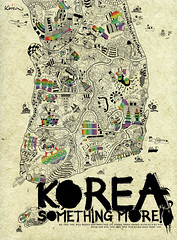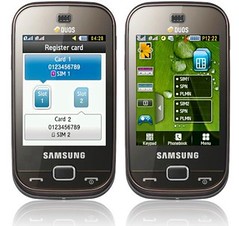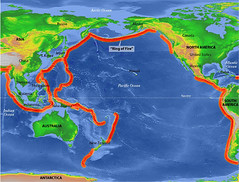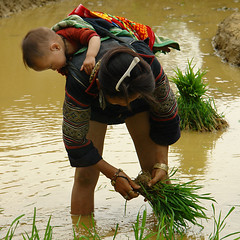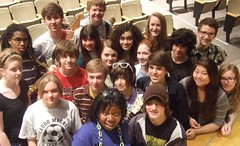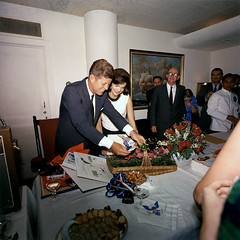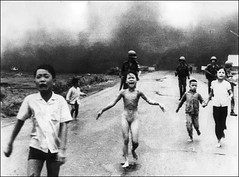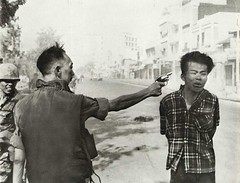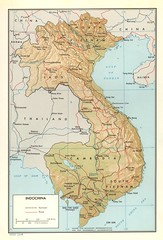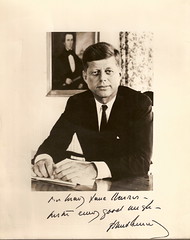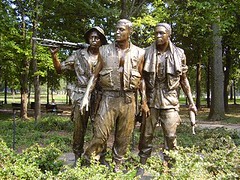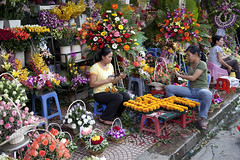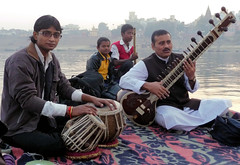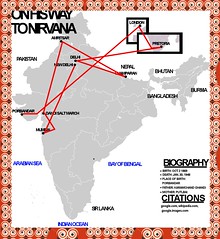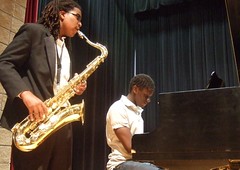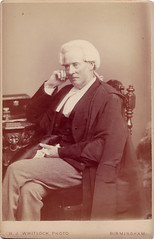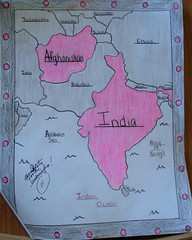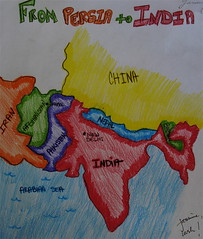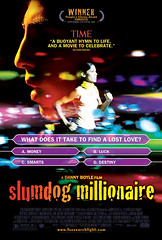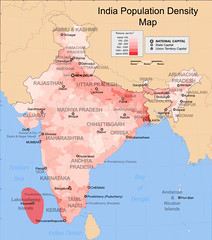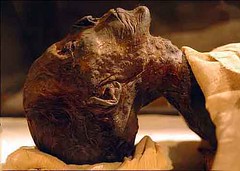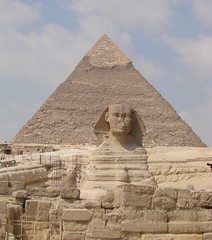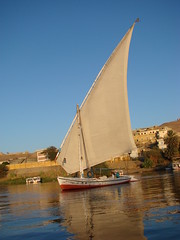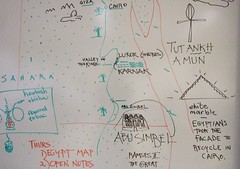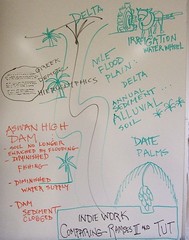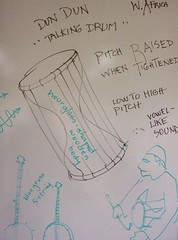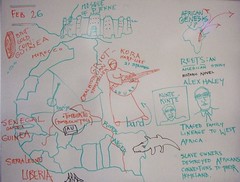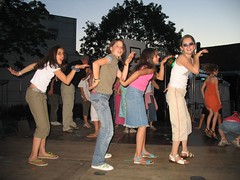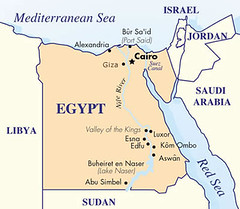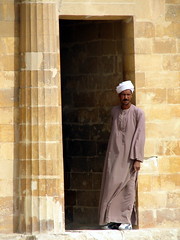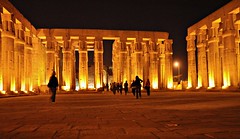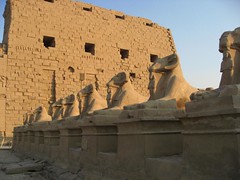The statistics and additional evidence in the project research - Vietnam, S Korea & N Korea - point to one of these East Asian nations as a surprising story.
In a brief paragraph on the page on which you are sketching a practice map please write a 2-sentence response -
Which nation stands out from the group of 3?
Which statistics or other evidence form the basis for your assertion?
Wednesday, March 31, 2010
Monday, March 29, 2010
Thurs, Ap 1: Vietnam plus Korea map quiz as well as Vietnam war open notes quiz
Vietnam / Korea map -
1. China
2. N. Korea
3. S. Korea
4. Pyongyang
5. Seoul
6. Yellow Sea
7. Sea of Japan
6. Pacific
9. Vietnam
10. Laos
10. Cambodia
11. Ho Chi Minh City (Saigon)
12. S. China Sea
1. China
2. N. Korea
3. S. Korea
4. Pyongyang
5. Seoul
6. Yellow Sea
7. Sea of Japan
6. Pacific
9. Vietnam
10. Laos
10. Cambodia
11. Ho Chi Minh City (Saigon)
12. S. China Sea
Korea: another nation divided between communist and democratic halves
Comparing the East Asian nations of Korea and Vietnam -
Google Doc presentation of 13 images -
1. Titling
2. - 4.
Demographics (pop, PCI, literacy, life expectancy)
- Vietnam
- S. Korea
- N. Korea
5. - 7.
US war in Korea / war in Vietnam comparison
- dates
- opposing forces
- US dead / Asian dead
8. - 10.
Profile S. Korea companies
- Samsung
- Hyundai
- Kia
11.- 12.
Map(s)
- N & S Korea
- Vietnam
(split-screen view OK)
13.
Documentation
- use one printed info site other than Wikipedia, please
Google Doc presentation of 13 images -
1. Titling
2. - 4.
Demographics (pop, PCI, literacy, life expectancy)
- Vietnam
- S. Korea
- N. Korea
5. - 7.
US war in Korea / war in Vietnam comparison
- dates
- opposing forces
- US dead / Asian dead
8. - 10.
Profile S. Korea companies
- Samsung
- Hyundai
- Kia
11.- 12.
Map(s)
- N & S Korea
- Vietnam
(split-screen view OK)
13.
Documentation
- use one printed info site other than Wikipedia, please
Friday, March 26, 2010
Orienting ourselves to the Pacific rim nations
Manufacturing and immigration are making the US less of a Eurocentric nation and more Asian-centric, I believe.
Thus we need to leave our dependence on maps that center on the Atlantic and spend more time studying Pacific nations.
Thus we need to leave our dependence on maps that center on the Atlantic and spend more time studying Pacific nations.
Thursday, March 25, 2010
Review of Presidents in Vietnam project
Truman: inherited the presidency and the decision of whether to drop the A bomb. Reasoned that it would ultimately save lives by bringing a quicker end to the war.
Eisenhower: 5-star general whose strategy helped defeat Hitler. As president, defined the Cold War as a mostly covert struggle against communism and communism's Domino Effect.
JFK: was able to out-poll the experienced leader Richard Nixon by virtue of his youthful good looks in the first televised presidential debate, 1960. Very slim margin of victory, reminding us of the Bush Vs. Gore election. JFK assassinated in 1963.
Lyndon Johnson: became president upon JFK's death. Used Gulf of Tonkin Resolution to make war against the North Viet communists.
Continually raised troop strength over several year period but could not produce a victory. His team thoroughly underestimated the enemy (sound familiar, as in Iraq?).
Using the draft to fill the ranks of the Army, incurred the wrath of the student protest movement. Demonstrations against the war - doves vs. hawks - grew from campus activity to large-scale marching in cities. Culminated with March on Washington (250,000 participants) in 1968.
Troop deployment in Vietnam peaks in '68 at some 500,000. The NVA & VC make a dramatic victory in '68 by a large-scale, surprise attack against our strongholds. Called the Tet Offensive, it marks a turning point in the war.
Richard Nixon: determined to best the communists Nixon used heavy bombing of North Vietnam to gain an advantage. Somehow, Ho Chi Minh's forces held out. Overall, Nixon managed the US exit from 'Nam. he also won praise by opening trade with communist China, at the time a backwards nation and "sleeping giant."
Nixon resigned in '74 due to the Watergate Scandal.
He and his aides had denied involvement in various "dirty tricks" against the Democrats in the election of '68. Journalists kept the inquiry alive and after several years of determined reporting, found the evidence that Nixon had known about the chicanery of his re-election team. When the US public learned that the president had lied about his involvement, Nixon lost the nation's support. he resigned rather than face impeachment.
Wednesday, March 24, 2010
Thanks for supporting the Class of 2013 Magnet Talent Show
Attendance at the Class of 2013 Magnet Talent Show on Wed, Mar 24, was terrific. Parents were much in evidence, as were freshmen supporting their classmates on stage.
Partly due to our many rehearsals, the performances were tight. The show ran smoothly, start to finish.
Performers -
Rachel Graham, Avery Alsandor, Shelby Bush, Chris Ezelle
Sean Nathan
Brooklyn White
Leanne Kerr, Henry Lin
Joshua Ursua
Henry Lin
Always Friday (Seth Dykes, Chris Ezelle, Nick Sorenson, Brennan Williams)
Shelby Bush
Aaron Wilson, Corey Atkins, Cody Jasper
Trevari Huff-Boone, Erick Coleman
Iggy (Meagan Poling)
JV Dance Line - Brianna Washington, Kayla __, Asha McDay, Te'nell Peoples
Waverly Hock, Joe Rossi, Joan Liu
Stage design and production: Larrson McSwain, Staveley Kuzmanov
Program design and production: Henry Lin
Back stage:
Rachel Thomson, Brittany Nguyen
Laura Sorkey, Cole Weinland
Ben Green
Sponsors:
Robert Trudeau, Ginger Marks
Support:
Bryan Gallant, Mary Rounds
Class of 2013 Parents
, especially Karen Bush and Mrs Lin.
See the program, designed by Henry Lin, at the class web site, Cmh13.com.
Partly due to our many rehearsals, the performances were tight. The show ran smoothly, start to finish.
Performers -
Rachel Graham, Avery Alsandor, Shelby Bush, Chris Ezelle
Sean Nathan
Brooklyn White
Leanne Kerr, Henry Lin
Joshua Ursua
Henry Lin
Always Friday (Seth Dykes, Chris Ezelle, Nick Sorenson, Brennan Williams)
Shelby Bush
Aaron Wilson, Corey Atkins, Cody Jasper
Trevari Huff-Boone, Erick Coleman
Iggy (Meagan Poling)
JV Dance Line - Brianna Washington, Kayla __, Asha McDay, Te'nell Peoples
Waverly Hock, Joe Rossi, Joan Liu
Stage design and production: Larrson McSwain, Staveley Kuzmanov
Program design and production: Henry Lin
Back stage:
Rachel Thomson, Brittany Nguyen
Laura Sorkey, Cole Weinland
Ben Green
Sponsors:
Robert Trudeau, Ginger Marks
Support:
Bryan Gallant, Mary Rounds
Class of 2013 Parents
, especially Karen Bush and Mrs Lin.
See the program, designed by Henry Lin, at the class web site, Cmh13.com.
Informal presidential review . . .
Four presidents associated w the conflict in Vietnam - a brief review -
1. Home state was California.
2. From Texas.
3. From Massachusetts.
4. WWII general in command of the European war.
5. Author of the book Profiles in Courage.
6. Responsible for pushing successful Civil Rights legislation.
7. Was earlier a vice president.
1. Home state was California.
2. From Texas.
3. From Massachusetts.
4. WWII general in command of the European war.
5. Author of the book Profiles in Courage.
6. Responsible for pushing successful Civil Rights legislation.
7. Was earlier a vice president.
Tuesday, March 23, 2010
Vietnam: 58,000 US dead, some 4 million Vietnamese dead
The war exacted a huge human cost in terms of fatalities, says Wikipedia, including 3 to 4 million Vietnamese from both sides, 1.5 to 2 million Laotians and Cambodians, and 58,159 U.S. soldiers.[16] By this war's end, the Vietnamese had been fighting foreign involvement or occupation in various wars for over a hundred years.
The monument above is on the National Mall, Wash, DC, near the Vietnam Wall.
The monument above is on the National Mall, Wash, DC, near the Vietnam Wall.
1972, South Vietnam: the Victims Of War
Phan Thị Kim Phúc, O.Ont (born 1963) is a Vietnamese-Canadian best known as the child subject of a Pulitzer Prize winning photograph taken during the Vietnam War on June 8, 1972, says Wikipedia.
The iconic photo taken in Trang Bang by AP photographer Nick Ut shows her at about age nine running naked on the street after being severely burned on her back by a South Vietnamese napalm attack.
Contrary to popular myth, the US Air Force were not involved in the attack, and only two US troops were within 60 mi (97 km) of the scene, neither of whom had any say in the bombings.[1]
The image of Phúc running naked amidst the chaos became one of the most haunting images of the Vietnam War. In an interview many years later, she recalled she was yelling "Nong qua, nong qua" ("too hot, too hot") in the picture.
After snapping the photograph, Út took Kim Phúc and the other injured children to a hospital in Saigon, where it was determined her burns were so severe that she probably would not survive. After a 14-month hospital stay and 17 surgical procedures, however, she was able to return home. Út continued to visit her until he was evacuated during the fall of Saigon, three years later.[2]
The iconic photo taken in Trang Bang by AP photographer Nick Ut shows her at about age nine running naked on the street after being severely burned on her back by a South Vietnamese napalm attack.
Contrary to popular myth, the US Air Force were not involved in the attack, and only two US troops were within 60 mi (97 km) of the scene, neither of whom had any say in the bombings.[1]
The image of Phúc running naked amidst the chaos became one of the most haunting images of the Vietnam War. In an interview many years later, she recalled she was yelling "Nong qua, nong qua" ("too hot, too hot") in the picture.
After snapping the photograph, Út took Kim Phúc and the other injured children to a hospital in Saigon, where it was determined her burns were so severe that she probably would not survive. After a 14-month hospital stay and 17 surgical procedures, however, she was able to return home. Út continued to visit her until he was evacuated during the fall of Saigon, three years later.[2]
Shot Heard Around The World: Execution of a Viet Cong Guerrilla, 1968
With North Vietnam’s Tet Offensive beginning, Nguyen Ngoc Loan, South Vietnam’s national police chief, was doing all he could to keep Viet Cong guerrillas from Saigon.
As Loan executed a prisoner who was said to be a Viet Cong captain, AP photographer Eddie Adams opened the shutter. Adams won a Pulitzer Prize for a picture that, as much as any, turned public opinion against the war. Adams felt that many misinterpreted the scene.
As Loan executed a prisoner who was said to be a Viet Cong captain, AP photographer Eddie Adams opened the shutter. Adams won a Pulitzer Prize for a picture that, as much as any, turned public opinion against the war. Adams felt that many misinterpreted the scene.
Due Thurs: Colorful map of Vietnam
Your map project on Vietnam and its neighbors can be created by hand or digitally.
- include 10 identifications
- color
- documentation
- border
Priorities -
1. Hanoi
2. da Nang
3. Ho Chi Minh City, formerly Saigon
4. Cambodia
5. Laos
6. China
7. South China Sea (part of the Pacific)
8. Mekong River (similar to the Mississippi)
9. Hong Kong, China
10. Thailand
11. Bangkok
- include 10 identifications
- color
- documentation
- border
Priorities -
1. Hanoi
2. da Nang
3. Ho Chi Minh City, formerly Saigon
4. Cambodia
5. Laos
6. China
7. South China Sea (part of the Pacific)
8. Mekong River (similar to the Mississippi)
9. Hong Kong, China
10. Thailand
11. Bangkok
Vietnam and the Chinese, French and the US: a history of rule by outsiders
Socialist Republic of Vietnam
With a population of over 86 million, Vietnam is the 13th most populous country in the world.
The people of Vietnam regained independence and broke away from China in AD 938.
It was colonized by the French in the mid-19th century.
Efforts to resist the French eventually led to their expulsion from the country in the mid-20th century, leaving a nation divided politically into two countries. Fighting between the two sides continued during the Vietnam War, ending with a North Vietnamese victory in 1975.
French Indochina: the French administration imposed significant political and cultural changes on Vietnamese society. A Western-style system of modern education was developed, and Christianity was propagated widely in Vietnamese society.
Developing a plantation economy to promote the exports of tobacco, indigo, tea and coffee, the French largely ignored increasing calls for self-government and civil rights.
In 1941, the Viet Minh — a communist and nationalist liberation movement — emerged under Ho Chi Minh, to seek independence for Vietnam from France as well as to oppose the Japanese occupation.
To support South Vietnam's struggle against the communist insurgency, the United States began increasing its contribution of military advisers.
US forces became embroiled in ground combat operations in 1965 and at their peak they numbered more than 500,000.[18][19]
Communist forces attacked most major targets in South Vietnam during the 1968 Tet Offensive, and although their campaign failed militarily, it shocked the American establishment, and caused them to think that the communists could not be defeated.[20]
Communist forces supplying the Vietcong carried supplies along the Ho Chi Minh trail, which passed through Laos and Cambodia. US president Richard Nixon authorized Operation Menu, a SAC bombing campaign in Laos and Cambodia, which he kept secret from the US Congress.[21][22]
Its own casualties mounting, and facing opposition to the war at home and condemnation abroad, the U.S. began withdrawing from ground combat roles according to the Nixon Doctrine; the process was subsequently called Vietnamization.
With a population of over 86 million, Vietnam is the 13th most populous country in the world.
The people of Vietnam regained independence and broke away from China in AD 938.
It was colonized by the French in the mid-19th century.
Efforts to resist the French eventually led to their expulsion from the country in the mid-20th century, leaving a nation divided politically into two countries. Fighting between the two sides continued during the Vietnam War, ending with a North Vietnamese victory in 1975.
French Indochina: the French administration imposed significant political and cultural changes on Vietnamese society. A Western-style system of modern education was developed, and Christianity was propagated widely in Vietnamese society.
Developing a plantation economy to promote the exports of tobacco, indigo, tea and coffee, the French largely ignored increasing calls for self-government and civil rights.
In 1941, the Viet Minh — a communist and nationalist liberation movement — emerged under Ho Chi Minh, to seek independence for Vietnam from France as well as to oppose the Japanese occupation.
To support South Vietnam's struggle against the communist insurgency, the United States began increasing its contribution of military advisers.
US forces became embroiled in ground combat operations in 1965 and at their peak they numbered more than 500,000.[18][19]
Communist forces attacked most major targets in South Vietnam during the 1968 Tet Offensive, and although their campaign failed militarily, it shocked the American establishment, and caused them to think that the communists could not be defeated.[20]
Communist forces supplying the Vietcong carried supplies along the Ho Chi Minh trail, which passed through Laos and Cambodia. US president Richard Nixon authorized Operation Menu, a SAC bombing campaign in Laos and Cambodia, which he kept secret from the US Congress.[21][22]
Its own casualties mounting, and facing opposition to the war at home and condemnation abroad, the U.S. began withdrawing from ground combat roles according to the Nixon Doctrine; the process was subsequently called Vietnamization.
In-class project: Four presidents and US involvement in Vietnam
Purpose: a review of 4 recent presidents and their role in the US conflict in Vietnam.
In this Google Doc report, please place your presidential notes atop 8 images -
1. Eisenhower
2. Vietnam war
3. JFK
4. Vietnam war
5. LBJ
6. Viet war
7. Nixon
8. Vietnam map
- Titling
- Documentation
- Edited notes - bulleted - on the 4 presidents.
- To be developed over 2 classes in the computer lab.
- 5 pts completion score on Wed.
In this Google Doc report, please place your presidential notes atop 8 images -
1. Eisenhower
2. Vietnam war
3. JFK
4. Vietnam war
5. LBJ
6. Viet war
7. Nixon
8. Vietnam map
- Titling
- Documentation
- Edited notes - bulleted - on the 4 presidents.
- To be developed over 2 classes in the computer lab.
- 5 pts completion score on Wed.
Monday, March 22, 2010
The largest and most technologically advanced ship of the ancient world: the Chinese junk
A junk is a Chinese sailboat design dating from ancient times and still in use today, says Wikipedia.
It was by far the largest ship design in ancient history and was technologically superior to European and other Asian designs.
Junks were developed during the Han Dynasty (220 BC–200 AD) and were used as ocean-going vessels as early as the 2nd century AD. They evolved in the later dynasties, and were built and used throughout Asia for extensive ocean voyages.
They were found, and in lesser numbers are still found, throughout South-East Asia and India, but primarily in China, perhaps today most famously in Hong Kong.
It was by far the largest ship design in ancient history and was technologically superior to European and other Asian designs.
Junks were developed during the Han Dynasty (220 BC–200 AD) and were used as ocean-going vessels as early as the 2nd century AD. They evolved in the later dynasties, and were built and used throughout Asia for extensive ocean voyages.
They were found, and in lesser numbers are still found, throughout South-East Asia and India, but primarily in China, perhaps today most famously in Hong Kong.
Indie work: briefly compare the war in Iraq and Vietnam
Research and integrate the topics and document your work in comparing
- The US wars in Vietnam and Iraq
- The hijab & chador and the ao dai.
Illustration: the additional Vietnam War Memorial in Wash, DC
- The US wars in Vietnam and Iraq
- The hijab & chador and the ao dai.
Illustration: the additional Vietnam War Memorial in Wash, DC
Vietnam veteran interview due Mon, Ap 5; 15 pts
One of the most rewarding projects of first-year social studies, according to many students and parents, is the Vietnam Vet Interview.
The most difficult part of the project is finding a veteran who can be interviewed. I will expect you to get help from your parents, extended family and friends and perhaps your minister or comparable youth leader.
My goal is to see my students sit down across the table from a veteran of a US war in Asia. So, in truth, if you can find a veteran of the Korean conflict (usually older than Viet vets) or even the rare veteran of WWII in the Pacific, you can substitute.
Vietnam is part of America's history that can guide our thinking in regards US involvement in Iraq and Afghanistan.
These Vietnam veteran questions are designed to create a low-stress interview. The primary reason for this interview is to give you experience in using a Primary Source. The material you gather will not come from a book or online entry; it will come from a person who was an eye witness. You will be gathering a bit of evidence as a student historian.
1. Name and your service branch?
2. Year(s) you served in Vietnam?
3. Your responsibilities in the service while in ‘Nam.
4. Locations you visited in Vietnam. In which place did you stay the longest?
5. The geography of the Vietnam you observed.
6. Climate?
7. Describe the people of Vietnam, both physically & psychologically.
8. Changes in your attitude toward the US in Vietnam. (optional)
9. What should teens learn about the conflict?
10. Your favorite movie or book about ‘Nam? (optional)
Add 5 war images and a map of 'Nam and you're done.
You may have the flexibility to use some 8 of the questions as you see fit. if the vet declines to interview an item, it's OK. Simply record his reason. If the vet seems talkative, please ask additional questions. This project becomes a part of history. It might be valuable in the future in American History class or another project.
Recording the interview electronically is a good idea. If you try to write down the responses both you and the interviewee might be frustrated. It is not easy to write down all the words that flow in the average interview.
Possibilities:
* A cassette recorder.
* Using a mic and simple software program to record into your computer.
* Record via your videocamera. If the vet does not want to be on camera, put on the lens cap. The voice will still be recorded.
Guidelines:
* Stop the interview and test the recording after a minute. It is easy to get weak sound and be frustrated later.
* Place the mic as close to the person's mouth as possible.
Put the results of the interview, plus images, in a Google Doc entitled Viet Vet. Share w trudeau11@gmail.com.
Remember: you must add 5 images of Vietnam and one Vietnam map.
15 pts.
Due Mon, Ap 5.
The most difficult part of the project is finding a veteran who can be interviewed. I will expect you to get help from your parents, extended family and friends and perhaps your minister or comparable youth leader.
My goal is to see my students sit down across the table from a veteran of a US war in Asia. So, in truth, if you can find a veteran of the Korean conflict (usually older than Viet vets) or even the rare veteran of WWII in the Pacific, you can substitute.
Vietnam is part of America's history that can guide our thinking in regards US involvement in Iraq and Afghanistan.
These Vietnam veteran questions are designed to create a low-stress interview. The primary reason for this interview is to give you experience in using a Primary Source. The material you gather will not come from a book or online entry; it will come from a person who was an eye witness. You will be gathering a bit of evidence as a student historian.
1. Name and your service branch?
2. Year(s) you served in Vietnam?
3. Your responsibilities in the service while in ‘Nam.
4. Locations you visited in Vietnam. In which place did you stay the longest?
5. The geography of the Vietnam you observed.
6. Climate?
7. Describe the people of Vietnam, both physically & psychologically.
8. Changes in your attitude toward the US in Vietnam. (optional)
9. What should teens learn about the conflict?
10. Your favorite movie or book about ‘Nam? (optional)
Add 5 war images and a map of 'Nam and you're done.
You may have the flexibility to use some 8 of the questions as you see fit. if the vet declines to interview an item, it's OK. Simply record his reason. If the vet seems talkative, please ask additional questions. This project becomes a part of history. It might be valuable in the future in American History class or another project.
Recording the interview electronically is a good idea. If you try to write down the responses both you and the interviewee might be frustrated. It is not easy to write down all the words that flow in the average interview.
Possibilities:
* A cassette recorder.
* Using a mic and simple software program to record into your computer.
* Record via your videocamera. If the vet does not want to be on camera, put on the lens cap. The voice will still be recorded.
Guidelines:
* Stop the interview and test the recording after a minute. It is easy to get weak sound and be frustrated later.
* Place the mic as close to the person's mouth as possible.
Put the results of the interview, plus images, in a Google Doc entitled Viet Vet. Share w trudeau11@gmail.com.
Remember: you must add 5 images of Vietnam and one Vietnam map.
15 pts.
Due Mon, Ap 5.
Washington to Hanoi: Vietnam review
Washington to Hanoi: Vietnam review
1. Geneva is a city in the nation of a) Netherlands
b) Switzerland c) Germany d) Belgium.
2. The Geneva Accord was part of ending the war between Vietnam and __ . a) France b) England
c) Belgium d) Netherlands.
3. Appropriate order of the presidents: a) Eisenhower, Nixon, Kennedy b) Kennedy, Nixon, Johnson
c) Nixon, LBJ, Eisenhower d) Eisenhower, JFK, LBJ
4. Not a Senator from Massachusetts: a) John F Kennedy
b) Dwight Eisenhower.
5. Commander-in-chief of US during Vietnam conflict:
a) Nixon b) Truman c) JFK d) Eisenhower.
6. President associated with secondary escalation of troops in Vietnam: a) Nixon b) JFK c) LBJ .
7. Gulf of Tonkin Resolution: a) Nixon b) JFK c) LBJ.
8. Tet Offensive: a) Nixon b) JFK c) LBJ.
9. Great Society: a) Nixon b) JFK c) LBJ.
10. End of Vietnam war, ‘73 - ‘75: a) Nixon b) JFK c) LBJ.
11. Domino Theory: a) Nixon b) JFK c) LBJ d) Eisenhower.
12. Tet Offensive: a) Hue b) Hanoi c) Bangkok
d) Cambodia.
13. Viet Cong: a) US b) China c) Japan.
14. Australians: a) US b) China c) Japan.
15. Protest march in Washington, DC: a) 1966 b) 1969
c) 1973 d) 1975.
16. Sent US advisers to Vietnam: a) LBJ b) Nixon
c) JFK.
17. Ho Chi Minh: a) Hanoi b) Hue c) Da Nang d) Saigon.
18. Indochina: a) France b) Belgium c) England d) US.
19. “Goodnight, Irene”: a) Dylan b) Leadbelly c) Hendrix.
20. Civil Rights march on Washington, DC: a) 1960
b) 1963 c) 1969 d) 1971.
21. President who banned racial discrimination in the military: a) LBJ b) JFK c) Nixon d) Eisenhower e) Truman.
22. Vietnam’s population today is about one third the US population. T / F
23. Vietnam is a communist nation today. T / F
24. Vietnamese boat people: a) 1954 b) 1966 c) 1969
d) 1975.
25. Not an example of Vietnamese ingenuity: a) punji traps
b) tunnel system c) betel nut.
Washington to Hanoi: Vietnam review
1. b 2. a 3. d 4. b 5. a 6. a 7. c 8. c 9. c 10. a 11. d 12. a
13. b 14. a 15. b 16. c 17. a or d 18. a 19. b 20. b 21. e 22. F 23. T 24. d 25. c
1. Geneva is a city in the nation of a) Netherlands
b) Switzerland c) Germany d) Belgium.
2. The Geneva Accord was part of ending the war between Vietnam and __ . a) France b) England
c) Belgium d) Netherlands.
3. Appropriate order of the presidents: a) Eisenhower, Nixon, Kennedy b) Kennedy, Nixon, Johnson
c) Nixon, LBJ, Eisenhower d) Eisenhower, JFK, LBJ
4. Not a Senator from Massachusetts: a) John F Kennedy
b) Dwight Eisenhower.
5. Commander-in-chief of US during Vietnam conflict:
a) Nixon b) Truman c) JFK d) Eisenhower.
6. President associated with secondary escalation of troops in Vietnam: a) Nixon b) JFK c) LBJ .
7. Gulf of Tonkin Resolution: a) Nixon b) JFK c) LBJ.
8. Tet Offensive: a) Nixon b) JFK c) LBJ.
9. Great Society: a) Nixon b) JFK c) LBJ.
10. End of Vietnam war, ‘73 - ‘75: a) Nixon b) JFK c) LBJ.
11. Domino Theory: a) Nixon b) JFK c) LBJ d) Eisenhower.
12. Tet Offensive: a) Hue b) Hanoi c) Bangkok
d) Cambodia.
13. Viet Cong: a) US b) China c) Japan.
14. Australians: a) US b) China c) Japan.
15. Protest march in Washington, DC: a) 1966 b) 1969
c) 1973 d) 1975.
16. Sent US advisers to Vietnam: a) LBJ b) Nixon
c) JFK.
17. Ho Chi Minh: a) Hanoi b) Hue c) Da Nang d) Saigon.
18. Indochina: a) France b) Belgium c) England d) US.
19. “Goodnight, Irene”: a) Dylan b) Leadbelly c) Hendrix.
20. Civil Rights march on Washington, DC: a) 1960
b) 1963 c) 1969 d) 1971.
21. President who banned racial discrimination in the military: a) LBJ b) JFK c) Nixon d) Eisenhower e) Truman.
22. Vietnam’s population today is about one third the US population. T / F
23. Vietnam is a communist nation today. T / F
24. Vietnamese boat people: a) 1954 b) 1966 c) 1969
d) 1975.
25. Not an example of Vietnamese ingenuity: a) punji traps
b) tunnel system c) betel nut.
Washington to Hanoi: Vietnam review
1. b 2. a 3. d 4. b 5. a 6. a 7. c 8. c 9. c 10. a 11. d 12. a
13. b 14. a 15. b 16. c 17. a or d 18. a 19. b 20. b 21. e 22. F 23. T 24. d 25. c
Friday, March 12, 2010
Sitar & Tabla: the unusual musical instruments of India
The sitar is long-necked, guitar-like instrument which makes a complex, droning and twinkling melody.
It has been played since the Middle Ages, says Wikipedia. It derives its sound from sympathetic strings (which are under the arched frets, amazingly), a long hollow neck and a gourd resonating chamber.
There may be up to 21 strings. Typical woods used in the construction include mahogany and teak. The body is based on a gourd which is carefully carved.
Tabla are a pair of hand drums of contrasting sizes and timbres. The term tabla is derived from an Arabic word, tabl, which simply means "drum." [1]
The heel of the hand is used to apply pressure or in a sliding motion on the larger drum so that the pitch is changed during the sound's decay.
The bāyāñ, the larger of the pair, has a much deeper bass tone, much like its distant cousin, the kettle drum. The bāyāñ may be made from brass - the most common - or copper, which is more expensive, but generally held to be the best, while aluminum and steel are often found in inexpensive models. One sometimes finds that wood and clay are also used.
The head of each drum has an inner spot called the syahi (lit. "ink"; a.k.a. shāī or gāb). This is constructed using multiple layers of a tuning paste made from starch (rice or wheat) mixed with a black powder of various origins. The precise construction and shaping of this area is responsible for modification of the drum's natural overtones, resulting in the clarity of pitch and variety of tonal possibilities unique to this instrument.
It has been played since the Middle Ages, says Wikipedia. It derives its sound from sympathetic strings (which are under the arched frets, amazingly), a long hollow neck and a gourd resonating chamber.
There may be up to 21 strings. Typical woods used in the construction include mahogany and teak. The body is based on a gourd which is carefully carved.
Tabla are a pair of hand drums of contrasting sizes and timbres. The term tabla is derived from an Arabic word, tabl, which simply means "drum." [1]
The heel of the hand is used to apply pressure or in a sliding motion on the larger drum so that the pitch is changed during the sound's decay.
The bāyāñ, the larger of the pair, has a much deeper bass tone, much like its distant cousin, the kettle drum. The bāyāñ may be made from brass - the most common - or copper, which is more expensive, but generally held to be the best, while aluminum and steel are often found in inexpensive models. One sometimes finds that wood and clay are also used.
The head of each drum has an inner spot called the syahi (lit. "ink"; a.k.a. shāī or gāb). This is constructed using multiple layers of a tuning paste made from starch (rice or wheat) mixed with a black powder of various origins. The precise construction and shaping of this area is responsible for modification of the drum's natural overtones, resulting in the clarity of pitch and variety of tonal possibilities unique to this instrument.
Indie work deadline Sun, Mar 14, noon, for this 9 weeks
Will be inputting grades this weekend. And will happily add independent work to your total if you put it in a GoogleDoc and share it to trudeau11@gmail.com.
Comparison essays make the most points: up to 10 pts.
Thanks to Eric Johnson for a neat logo!
Comparison essays make the most points: up to 10 pts.
Thanks to Eric Johnson for a neat logo!
Wednesday, March 10, 2010
Freshman Talent Show: Wed, Mar 24, 6:30 pm, PAC; invite friends and family
The Freshman Talent Show will be performed the week after Spring Break: it will be at 6:30 pm on Wed, March 24, in the PAC.
Among the acts:
- Always Friday - a group featuring Nicholas Sorensen, Seth Dykes, Chris Ezelle, Brennan Williams
- LeAnne Kerr, Henry Linn - vocal & piano
- Joshua Ursua - solo piano
- Meagan Poling - guitar & vocal
- Henry Lin - solo piano
- Shelby Bush - guitar & vocal
- Aaron Wilson and dance team
- Avery Alsandor & Rachel Graham plus Shelby Bush, vocals & guitar
- JV Dance Line
Among the acts:
- Always Friday - a group featuring Nicholas Sorensen, Seth Dykes, Chris Ezelle, Brennan Williams
- LeAnne Kerr, Henry Linn - vocal & piano
- Joshua Ursua - solo piano
- Meagan Poling - guitar & vocal
- Henry Lin - solo piano
- Shelby Bush - guitar & vocal
- Aaron Wilson and dance team
- Avery Alsandor & Rachel Graham plus Shelby Bush, vocals & guitar
- JV Dance Line
Shreveport's Hindu Cultural Center since 2006
Welcome to the Sadhu Vaswani Hindu Cultural Center and Hindu Temple
6526 Jefferson Paige Road, Shreveport, LA 71119
Every thing I have is a loan given to me to be passed on to those whose need is greater than mine.
- Sadhu T.L. Vaswani
6526 Jefferson Paige Road, Shreveport, LA 71119
Every thing I have is a loan given to me to be passed on to those whose need is greater than mine.
- Sadhu T.L. Vaswani
Western world stress relief: Hatha Yoga from India
Yoga (Sanskrit, Pāli: योग yóga) refers to traditional physical and mental disciplines originating in India, says Wikipedia.[1] The word is associated with meditative practices in Hinduism, Buddhism and Jainism.
The Sanskrit word yoga has many meanings,[11] and is derived from the Sanskrit root "yuj", meaning "to control", "to yoke" or "to unite."[12] Translations include "joining", "uniting", "union", "conjunction", and "means".
Outside India, the term yoga is typically associated with Hatha Yoga and its asanas (postures) or as a form of exercise. Someone who practices yoga or follows the yoga philosophy is called a yogi or yogini.
The Bhagavad Gita ('Song of the Lord'), uses the term yoga extensively in a variety of ways. In addition to an entire chapter (ch. 6) dedicated to traditional yoga practice, including meditation,[41] it introduces three prominent types of yoga:[42]
* Karma yoga: The yoga of action,
* Bhakti yoga: The yoga of devotion,
* Gnana yoga: The yoga of knowledge.
Traditional Hatha Yoga is a holistic yogic path, including moral disciplines, physical postures (asana), purification procedures (shatkriya), poses (mudra), yogic breathing (pranayama), and meditation. The Hatha yoga predominantly practiced in the West consists of mostly asanas understood as physical exercises. It is also recognized as a stress-reducing practice.
Hatha is a compound of the words Ha and Tha meaning sun and moon ( हकारः कीर्तितः सूर्यष्ठकारश्चंद्र उच्यते | सूर्यचंद्रमसोर्योगाद्धठयोग निगद्यते || ), referring to Praana and Apaana, and also to the principal nadis (energy channels) of the subtle body that must be fully operational to attain a state of dhyana or samādhi.
The Sanskrit word yoga has many meanings,[11] and is derived from the Sanskrit root "yuj", meaning "to control", "to yoke" or "to unite."[12] Translations include "joining", "uniting", "union", "conjunction", and "means".
Outside India, the term yoga is typically associated with Hatha Yoga and its asanas (postures) or as a form of exercise. Someone who practices yoga or follows the yoga philosophy is called a yogi or yogini.
The Bhagavad Gita ('Song of the Lord'), uses the term yoga extensively in a variety of ways. In addition to an entire chapter (ch. 6) dedicated to traditional yoga practice, including meditation,[41] it introduces three prominent types of yoga:[42]
* Karma yoga: The yoga of action,
* Bhakti yoga: The yoga of devotion,
* Gnana yoga: The yoga of knowledge.
Traditional Hatha Yoga is a holistic yogic path, including moral disciplines, physical postures (asana), purification procedures (shatkriya), poses (mudra), yogic breathing (pranayama), and meditation. The Hatha yoga predominantly practiced in the West consists of mostly asanas understood as physical exercises. It is also recognized as a stress-reducing practice.
Hatha is a compound of the words Ha and Tha meaning sun and moon ( हकारः कीर्तितः सूर्यष्ठकारश्चंद्र उच्यते | सूर्यचंद्रमसोर्योगाद्धठयोग निगद्यते || ), referring to Praana and Apaana, and also to the principal nadis (energy channels) of the subtle body that must be fully operational to attain a state of dhyana or samādhi.
Monday, March 08, 2010
Gandhi's tactics: use media, the law, Christianity and British fairness to aid India's cause
Gandhi attacked his various causes - Home Rule, the caste system, poverty, Muslim-Hindu conflict - with a variety of approaches:
1. He used the world media quite well. NYTimes reporters frequently covered his activities and movie news cameras found him a good subject. He knew that world opinion mostly favored the underdog.
2. With his background as a lawyer trained in London, Gandhi knew how to use the British legal system to his advantage.
3. The principles of Christianity called for fair treatment of minorities, he realized.
4. The British sense of democracy and general fairness could be applied to the plight of the people of India.
Later these tactics would be used by Both Martin Luther King, Jr, in the US Civil Rights protest and by Nelson Mandela in the struggle for indigenous people's rights in South Africa.
1. He used the world media quite well. NYTimes reporters frequently covered his activities and movie news cameras found him a good subject. He knew that world opinion mostly favored the underdog.
2. With his background as a lawyer trained in London, Gandhi knew how to use the British legal system to his advantage.
3. The principles of Christianity called for fair treatment of minorities, he realized.
4. The British sense of democracy and general fairness could be applied to the plight of the people of India.
Later these tactics would be used by Both Martin Luther King, Jr, in the US Civil Rights protest and by Nelson Mandela in the struggle for indigenous people's rights in South Africa.
Watching the movie Gandhi for useful quotes . . .
Try to capture 2 quotes each day from watching the movie. If not the exact words, try to capture the theme of the quote and the person who said it.
Examples :
"I've warned you!" S. Af mine manager in reference to the protest march. "We've warned each other." Said Gandhi, refusing to be intimidated.
"One king; one law!" Protest chant by protesters. It was a plea for fairness.
" What do we think when men defy and unjust law?" Minister Charlie Andrews, in a sermon in S Af. Reminded me of American history and the Civil Rights movement.
"We are trying to make a nation, but the British keep trying to divide us." Mr Gokhle, at the Home Rule gathering.
Examples :
"I've warned you!" S. Af mine manager in reference to the protest march. "We've warned each other." Said Gandhi, refusing to be intimidated.
"One king; one law!" Protest chant by protesters. It was a plea for fairness.
" What do we think when men defy and unjust law?" Minister Charlie Andrews, in a sermon in S Af. Reminded me of American history and the Civil Rights movement.
"We are trying to make a nation, but the British keep trying to divide us." Mr Gokhle, at the Home Rule gathering.
India: land of many cuisines
The cuisine of India is characterized by the use of spices, herbs and vegetables grown in India and also for the widespread practice of vegetarianism. Each family of Indian cuisine is characterized by a wide assortment of dishes and cooking techniques, says Wikipedia.
Around 7,000 BC, sesame, eggplant, and humped cattle had been domesticated in the Indus Valley.[12] By 3000 BC, turmeric, cardamom, black pepper and mustard were harvested in India.[13]
In Vedic (ancient) times, a normal diet consisted of fruit, vegetables, meat, grain, dairy products and honey.[14]
Over time, some segments of the population embraced vegetarianism, due to the ancient Hindu philosophy of ahimsa, which forbids killing or injuring of living beings.[15]
Buddhism, among several other beliefs and practices borrowed vegetarianism from Hinduism to embrace Ahimsa.
invasions from Central Asia, Arabia, the Mughal empire, Persia, and elsewhere had a deep and fundamental effect on Indian cooking. Influence from traders such as the Arab and Portuguese diversified subcontinental tastes and meals. As with other cuisines, Indian cuisine has absorbed New World vegetables such as tomato, chilli, and potato, as staples.
The popularity of curry, which originated in India, across Asia has often led to the dish being labeled as the "pan-Asian" dish.[32] Curry's international appeal has also been compared to that of pizza.[33]
Though the tandoor did not originate in India, Indian tandoori dishes, such as chicken tikka made with Indian ingredients, enjoy widespread popularity.[34]
Historically, Indian spices and herbs were one of the most sought after trade commodities. The spice trade between India and Europe led to the rise and dominance of Arab traders to such an extent that European explorers, such as Vasco da Gama and Christopher Columbus, set out to find new trade routes with India leading to the Age of Discovery.[4]
Around 7,000 BC, sesame, eggplant, and humped cattle had been domesticated in the Indus Valley.[12] By 3000 BC, turmeric, cardamom, black pepper and mustard were harvested in India.[13]
In Vedic (ancient) times, a normal diet consisted of fruit, vegetables, meat, grain, dairy products and honey.[14]
Over time, some segments of the population embraced vegetarianism, due to the ancient Hindu philosophy of ahimsa, which forbids killing or injuring of living beings.[15]
Buddhism, among several other beliefs and practices borrowed vegetarianism from Hinduism to embrace Ahimsa.
invasions from Central Asia, Arabia, the Mughal empire, Persia, and elsewhere had a deep and fundamental effect on Indian cooking. Influence from traders such as the Arab and Portuguese diversified subcontinental tastes and meals. As with other cuisines, Indian cuisine has absorbed New World vegetables such as tomato, chilli, and potato, as staples.
The popularity of curry, which originated in India, across Asia has often led to the dish being labeled as the "pan-Asian" dish.[32] Curry's international appeal has also been compared to that of pizza.[33]
Though the tandoor did not originate in India, Indian tandoori dishes, such as chicken tikka made with Indian ingredients, enjoy widespread popularity.[34]
Historically, Indian spices and herbs were one of the most sought after trade commodities. The spice trade between India and Europe led to the rise and dominance of Arab traders to such an extent that European explorers, such as Vasco da Gama and Christopher Columbus, set out to find new trade routes with India leading to the Age of Discovery.[4]
Gandhi map project due Thurs; 15 pts
In your notebook . . .
Create a 3-continent map that shows the principal locations in the life of Mohandas K Gandhi.
- Vibrant title.
- Color.
- Neatness, grammar, spelling.
- Bulleted biography of Gandhi (5 items).
- Bodies of water - 3.
- Nations that neighbor India - 6.
- Can be produced by hand or digitally.
- Include arrows showing his movement.
- Documentation at bottom.
Locations -
1. Porbandar, India. G's city of birth.
2. London, England. Attended law school.
3. Pretoria, South Africa. he spent 20 years protesting injustice against Indian immigrants.
4. Delhi. Gandhi returns to India in 1915.
5. Champaran. Site of Gandhi's first protest victory in India.
6. Amritsar. Site of a horrific massacre of unarmed Hindus by British soldiers.
7. Salt March to Dandi, near Porbandar. A protest against the salt tax.
8. Mumbai / Poona. Site of his last lengthy imprisonment.
9. New Delhi. Site of his assassination in 1948.
Submit at beginning of class Thurs, Mar 11. Late penalty: 3 pts. per day.
Also -
Open Notes quiz on India and Gandhi on Thurs, Mar 11.
Create a 3-continent map that shows the principal locations in the life of Mohandas K Gandhi.
- Vibrant title.
- Color.
- Neatness, grammar, spelling.
- Bulleted biography of Gandhi (5 items).
- Bodies of water - 3.
- Nations that neighbor India - 6.
- Can be produced by hand or digitally.
- Include arrows showing his movement.
- Documentation at bottom.
Locations -
1. Porbandar, India. G's city of birth.
2. London, England. Attended law school.
3. Pretoria, South Africa. he spent 20 years protesting injustice against Indian immigrants.
4. Delhi. Gandhi returns to India in 1915.
5. Champaran. Site of Gandhi's first protest victory in India.
6. Amritsar. Site of a horrific massacre of unarmed Hindus by British soldiers.
7. Salt March to Dandi, near Porbandar. A protest against the salt tax.
8. Mumbai / Poona. Site of his last lengthy imprisonment.
9. New Delhi. Site of his assassination in 1948.
Submit at beginning of class Thurs, Mar 11. Late penalty: 3 pts. per day.
Also -
Open Notes quiz on India and Gandhi on Thurs, Mar 11.
Sari vs kimono and other indie comparison topics
Indie work: comparison essays on . . .
Research, compare and compose carefully -
a) Styles of dress in India, incuding the Sari, vs Japanese styles, incl. the kimono
or
b) Siddhartha Gautama - the Buddha - vs Gandhi
Remember -
- Snaqqy titles
- Vivid opening.
- Integrate topics.
- Include detail.
- Document.
- Grammar & speeling
Research, compare and compose carefully -
a) Styles of dress in India, incuding the Sari, vs Japanese styles, incl. the kimono
or
b) Siddhartha Gautama - the Buddha - vs Gandhi
Remember -
- Snaqqy titles
- Vivid opening.
- Integrate topics.
- Include detail.
- Document.
- Grammar & speeling
Sunday, March 07, 2010
The 78-year journey of Mohandas Karamchand Gandhi
Gandhi's life began pleasantly in the home of a merchant caste family in Porbandar, India. This city on the Indian Ocean is also on the Arabian Sea. Thus Gandhi was exposed to sailors and merchants from Europe, SW Asia and Africa, he said.
As a resident in the most important of all the British colonies, he attended law school in London.
His first 20 years of life as a social activist were spent in Pretoria, South Africa. He learned the art of political protest and non-violent resistance by his efforts on behalf of Hindus and Muslim Indians who were in South Africa to work in the mines.
Gandhi returned to India to work in the Home Rule Movement in 1915. For the next 30 years he struggled to organize the masses of mostly-impoverished Indians. Wikipedia says, "Gandhi led nationwide campaigns to ease poverty, expand women's rights, build religious and ethnic amity, end untouchability, and increase economic self-reliance."
His protests took place in Delhi, in Champaran, in Amritsar, in the Salt march from Ahmedabad to Dandi, in Gujurat Province, in Bombay and - in his most famous imprisonment, Poona. He was assassinated in New Delhi in 1948.
The subcontinent gained independence from the United Kingdom in 1947, after being partitioned into the dominions of India and Pakistan.
As a resident in the most important of all the British colonies, he attended law school in London.
His first 20 years of life as a social activist were spent in Pretoria, South Africa. He learned the art of political protest and non-violent resistance by his efforts on behalf of Hindus and Muslim Indians who were in South Africa to work in the mines.
Gandhi returned to India to work in the Home Rule Movement in 1915. For the next 30 years he struggled to organize the masses of mostly-impoverished Indians. Wikipedia says, "Gandhi led nationwide campaigns to ease poverty, expand women's rights, build religious and ethnic amity, end untouchability, and increase economic self-reliance."
His protests took place in Delhi, in Champaran, in Amritsar, in the Salt march from Ahmedabad to Dandi, in Gujurat Province, in Bombay and - in his most famous imprisonment, Poona. He was assassinated in New Delhi in 1948.
The subcontinent gained independence from the United Kingdom in 1947, after being partitioned into the dominions of India and Pakistan.
Friday, March 05, 2010
Mumbai / Bombay: one of the world's most populous cities and home of Bollywood
Mumbai is the center of India's Hindi film and television industry, known as Bollywood. Mumbai's business opportunities, as well as its potential to offer a higher standard of living, attract migrants from all over India and, in turn, make the city a potpourri of many communities and cultures.
Mumbai, the most populous city in India, is one of the most populous cities in the world, with a population of approximately 14 million.
For centuries, the seven islands of Mumbia came under the control of indigenous empires before being ceded to Portuguese settlers and subsequently to the British East India Company.
During the mid-18th century, Bombay was reshaped by the British with large-scale civil engineering projects, aimed at merging all the seven islands into a single amalgamated mass[5], and emerged as a significant trading town. Economic and educational development characterised the city during the 19th century. It became a strong base for the Indian independence movement during the early 20th century.
Mumbai, the most populous city in India, is one of the most populous cities in the world, with a population of approximately 14 million.
For centuries, the seven islands of Mumbia came under the control of indigenous empires before being ceded to Portuguese settlers and subsequently to the British East India Company.
During the mid-18th century, Bombay was reshaped by the British with large-scale civil engineering projects, aimed at merging all the seven islands into a single amalgamated mass[5], and emerged as a significant trading town. Economic and educational development characterised the city during the 19th century. It became a strong base for the Indian independence movement during the early 20th century.
Slumdog Millionaire and other recommended movies on India
Each family has their standards in regards movie ratings. With no disrespect, I offer a variety of movies for adding depth to our studies of India. Check the ratings, please, before renting them.
- Slumdog Millionaire - the latest of ancient and modern India come to life.
- Salaam Bombay - about the desperate lives of impoverished children in Mumbai.
- Monsoon Wedding - the drama and comedy that surrounds a modern, elaborate Indian wedding.
- Mississippi Masala - A romantic movie about an Indian family - with beautiful daughter - that moves to Mississippi.
- Slumdog Millionaire - the latest of ancient and modern India come to life.
- Salaam Bombay - about the desperate lives of impoverished children in Mumbai.
- Monsoon Wedding - the drama and comedy that surrounds a modern, elaborate Indian wedding.
- Mississippi Masala - A romantic movie about an Indian family - with beautiful daughter - that moves to Mississippi.
India: Land of Curry, land of Hinduism
The greater map of India
Split apart from India about 1947
- Pakistan
- Bangladesh
- Himalayas
- Mt Everest
- Indian Ocean
- Kolkata
- Mumbai / Bollywood
Bangalore - city of large development centers by Microsoft, Dell and other companies.
- Mother Teresa / Kolkata
Demographics
- Dravidian people, the indigenous
- Aryans, ancient invaders
- Muslims from Arabia, Persia
Today -
80% Hindu, 13% Muslim
- Muslim nations: Pakistan, Bangladesh
Hindu vs Muslim violence a long tradition.
Split apart from India about 1947
- Pakistan
- Bangladesh
- Himalayas
- Mt Everest
- Indian Ocean
- Kolkata
- Mumbai / Bollywood
Bangalore - city of large development centers by Microsoft, Dell and other companies.
- Mother Teresa / Kolkata
Demographics
- Dravidian people, the indigenous
- Aryans, ancient invaders
- Muslims from Arabia, Persia
Today -
80% Hindu, 13% Muslim
- Muslim nations: Pakistan, Bangladesh
Hindu vs Muslim violence a long tradition.
Thursday, March 04, 2010
Indie work: comparison essays on . . .
Research, compare and compose carefully -
a) Maria Montessori and Cleopatra VII
or
b) Ramses II and William Henry "Bill" Gates III
Remember -
- Snaqqy titles
- Vivid opening.
- Integrate topics.
- Include detail.
- Document.
- Grammar & speeling.
a) Maria Montessori and Cleopatra VII
or
b) Ramses II and William Henry "Bill" Gates III
Remember -
- Snaqqy titles
- Vivid opening.
- Integrate topics.
- Include detail.
- Document.
- Grammar & speeling.
Wednesday, March 03, 2010
The Ankh: symbol of eternal life
The ankh (U+2625 ☥, 'key of life', 'the key of the Nile', 'crux ansata') was the Egyptian hieroglyphic character that read "eternal life," says Wikipedia.
The ankh appears frequently in Egyptian tomb paintings and other art, often at the fingertips of a god or goddess in images that represent the deities of the afterlife conferring the gift of life on the dead person's mummy; this is thought to symbolize the act of conception[citation needed]. Additionally, an ankh was often carried by Egyptians as an amulet, either alone, or in connection with two other hieroglyphs that mean "strength" and "health"
The ankh appears frequently in Egyptian tomb paintings and other art, often at the fingertips of a god or goddess in images that represent the deities of the afterlife conferring the gift of life on the dead person's mummy; this is thought to symbolize the act of conception[citation needed]. Additionally, an ankh was often carried by Egyptians as an amulet, either alone, or in connection with two other hieroglyphs that mean "strength" and "health"
March named for Roman god of war & fertility: Mars
Mars was the Roman god of war, the son of Juno and Jupiter, husband of Bellona, and the lover of Venus, says Wikipedia.
He was the most prominent of the military gods that were worshipped by the Roman legions. The martial Romans considered him second in importance only to Jupiter (their main god). His festivals were held in March (named for him) and October.
Initially Mars was a Roman god of fertility and vegetation and a protector of cattle, fields and boundaries and farmers.
He was the most prominent of the military gods that were worshipped by the Roman legions. The martial Romans considered him second in importance only to Jupiter (their main god). His festivals were held in March (named for him) and October.
Initially Mars was a Roman god of fertility and vegetation and a protector of cattle, fields and boundaries and farmers.
Pharaoh Hatshepsut, female ruler about 1500 BCE of the New Kingdom
Hatshepsut, meaning Foremost of Noble Ladies,[4] (1508 BC - 1458 BC), is generally regarded by Egyptologists as one of the most successful pharaohs, reigning longer than any other woman of an indigenous Egyptian dynasty, says Wikipedia.
Although it was uncommon for Egypt to be ruled by a woman, the situation was not unprecedented.
In comparison with other female pharaohs, Hatshepsut's reign was long and prosperous. She was successful in warfare early in her reign, but generally is considered to be a pharaoh who inaugurated a long peaceful era.
She re-established trading relationships lost during a foreign occupation and brought great wealth to Egypt. That wealth enabled Hatshepsut to initiate building projects that raised the calibre of Ancient Egyptian architecture to a standard, comparable to classical architecture, that would not be rivaled by any other culture for a thousand years.
She oversaw the preparations and funding for a mission to the Land of Punt. Most notably the Egyptians returned from the voyage bearing live frankincense trees, the roots of which were carefully kept in baskets for the duration of the voyage. This was the first recorded attempt to transplant foreign trees.
Hatshepsut was one of the most prolific builders in ancient Egypt, commissioning hundreds of construction projects throughout both Upper Egypt and Lower Egypt, that were grander and more numerous than those of any of her Middle Kingdom predecessors. Later pharaohs attempted to claim some of her projects as theirs.
She had twin obelisks, at the time the tallest in the world, erected at the entrance to the temple at Karnak.
Following the tradition of many pharaohs, the masterpiece of Hatshepsut's building projects was her mortuary temple. She built hers in a complex at Deir el-Bahri.
Women had a high status in ancient Egypt and enjoyed the legal right to own, inherit, or will property. A woman becoming pharaoh was rare, however.
Hatshepsut assumed all of the regalia and symbols of the pharaonic office in official representations: the Khat head cloth, topped with the uraeus, the traditional false beard, and shendyt kilt.[17] Many existing statues alternatively show her in typically feminine attire as well as those that depict her in the royal ceremonial attire.
If the recent identification of her mummy is correct, computed tomography would indicate that she died of blood infection while she was in her fifties.[2][28] It also would suggest that she had arthritis, bad teeth, and probably had diabetes.[2]
Toward the end of the reign of Thutmose III and into the reign of his son, an attempt was made to remove Hatshepsut from certain historical and pharaonic records. This elimination was carried out in the most literal way possible. Her cartouches and images were chiselled off some stone walls, leaving very obvious Hatshepsut-shaped gaps in the artwork.
Although it was uncommon for Egypt to be ruled by a woman, the situation was not unprecedented.
In comparison with other female pharaohs, Hatshepsut's reign was long and prosperous. She was successful in warfare early in her reign, but generally is considered to be a pharaoh who inaugurated a long peaceful era.
She re-established trading relationships lost during a foreign occupation and brought great wealth to Egypt. That wealth enabled Hatshepsut to initiate building projects that raised the calibre of Ancient Egyptian architecture to a standard, comparable to classical architecture, that would not be rivaled by any other culture for a thousand years.
She oversaw the preparations and funding for a mission to the Land of Punt. Most notably the Egyptians returned from the voyage bearing live frankincense trees, the roots of which were carefully kept in baskets for the duration of the voyage. This was the first recorded attempt to transplant foreign trees.
Hatshepsut was one of the most prolific builders in ancient Egypt, commissioning hundreds of construction projects throughout both Upper Egypt and Lower Egypt, that were grander and more numerous than those of any of her Middle Kingdom predecessors. Later pharaohs attempted to claim some of her projects as theirs.
She had twin obelisks, at the time the tallest in the world, erected at the entrance to the temple at Karnak.
Following the tradition of many pharaohs, the masterpiece of Hatshepsut's building projects was her mortuary temple. She built hers in a complex at Deir el-Bahri.
Women had a high status in ancient Egypt and enjoyed the legal right to own, inherit, or will property. A woman becoming pharaoh was rare, however.
Hatshepsut assumed all of the regalia and symbols of the pharaonic office in official representations: the Khat head cloth, topped with the uraeus, the traditional false beard, and shendyt kilt.[17] Many existing statues alternatively show her in typically feminine attire as well as those that depict her in the royal ceremonial attire.
If the recent identification of her mummy is correct, computed tomography would indicate that she died of blood infection while she was in her fifties.[2][28] It also would suggest that she had arthritis, bad teeth, and probably had diabetes.[2]
Toward the end of the reign of Thutmose III and into the reign of his son, an attempt was made to remove Hatshepsut from certain historical and pharaonic records. This elimination was carried out in the most literal way possible. Her cartouches and images were chiselled off some stone walls, leaving very obvious Hatshepsut-shaped gaps in the artwork.
Tuesday, March 02, 2010
Egyptian overview: from the Pharaonic period to the Arabic era
1. Who were the outsiders who trekked deeply into North and West Africa - about the year 1000 AD - to trade and leave behind their cultural influences?
a) Arabs b) Romans c) Greeks d) Hindus
The desert-wise Arabs!
2. These intrepid traders crossed the Sahara to trade with the peoples of West Africa. The motivation for such a trek was (choose 3):
a) slaves b) gold c) ivory d) fabrics e) masks f) music & dance.
Slaves, gold & ivory - today the world loves the fabrics, masks and music & dance of the African continent.
3. The Romans conquered the lands on the rim of North Africa about the time of Christ. They established trade with and built cities in 5 African-Mediterranean nations: __, __, __, __, & __. Please see your atlas.
4. East Africa's trading neighbors would be the Arabs and others from the nations that lie closest to the border. These 4 nations would be __, __, __ & __. See yr atlas , please.
5. Which location offers evidence that the Arabs sailed down the east coast of Africa to establish trading centers? a) Mogadishu b) Mombasa c) Dar es Salaam.
Dar es salaam means the"haven of peace" in Arabic.
6. Did the Pharaonic era Egyptians have serious trouble from Midddle Eastern tribal nations? Yes / No.
Yes. In fact, peoples from Palestine/Lebanon, the Hyksos, conquered and ruled Egypt for a time during the age of the Pharaohs.
7. The "look" of a modern Egyptian: does he look a bit like the ancient Pharaohs and a bit like a blend of the ethnic groups who've invaded Egypt over the centuries? Do Egyptians look like a "crossroads" people? Yes / No .
Yes. This is my opinion, but I spent 6 weeks studying Egypt and Egyptians on a Fulbright Fellowship, so ...
8. What is the area of Egypt? __ million sq. miles. Is it about the same as that of Nigeria? __ million sq. miles.
9. What is the population of Egypt? __ million The population of Nigeria? __ million
10. How do you explain the differences between the Egyptian and Nigerian statistics? _____________
Which came first, the Great Pyramids or the Valley of the Kings?
The pyramids came from the Old Kingdom, the Valley of the Kings from the Middle Kingdom.
* Egypt was part of the Roman Empire. Supplied wheat to Rome and the rest of the empire. Was a source of wild animals used in the coliseums' gladiatorial extravaganzas.
* The reading of hieroglyphic messages fell into disuse after the invasion of Alexander the Great (which preceded the Roman era). He brought the Greek language and culture to Egypt and the Middle East. With the extinction of the priest class and the old-style pharaohs, Hieroglyphics were replaced by Greek and Demotic script.
* Rosetta Stone: in 1799 Napoleon's soldiers dug up a basalt announcement stone with 3 scripts: Greek, Demotic and Hieroglyphics. Written about 200 BC, it was the key to translating the hieroglyphics. Credit for translation goes to Frenchman Jean Francois Chompollion.
Today the Rosetta Stone is in the British Museum, London.
* The white limestone blocks that clad the Great Pyramids in a smooth "skin" were also lost in antiquity. They were taken from the Pyramids to be used as building stone for palaces and businesses. Subsequently the dark, 2-ton blocks which make the body of the pyramids are bare.
* Another lost technology: how to make glass of the type found in the blue bands of King Tut's golden burial mask.
Cairo, Time Life Books.
World History Encyclopedia, DP.
The Arab World, Time/Life.
a) Arabs b) Romans c) Greeks d) Hindus
The desert-wise Arabs!
2. These intrepid traders crossed the Sahara to trade with the peoples of West Africa. The motivation for such a trek was (choose 3):
a) slaves b) gold c) ivory d) fabrics e) masks f) music & dance.
Slaves, gold & ivory - today the world loves the fabrics, masks and music & dance of the African continent.
3. The Romans conquered the lands on the rim of North Africa about the time of Christ. They established trade with and built cities in 5 African-Mediterranean nations: __, __, __, __, & __. Please see your atlas.
4. East Africa's trading neighbors would be the Arabs and others from the nations that lie closest to the border. These 4 nations would be __, __, __ & __. See yr atlas , please.
5. Which location offers evidence that the Arabs sailed down the east coast of Africa to establish trading centers? a) Mogadishu b) Mombasa c) Dar es Salaam.
Dar es salaam means the"haven of peace" in Arabic.
6. Did the Pharaonic era Egyptians have serious trouble from Midddle Eastern tribal nations? Yes / No.
Yes. In fact, peoples from Palestine/Lebanon, the Hyksos, conquered and ruled Egypt for a time during the age of the Pharaohs.
7. The "look" of a modern Egyptian: does he look a bit like the ancient Pharaohs and a bit like a blend of the ethnic groups who've invaded Egypt over the centuries? Do Egyptians look like a "crossroads" people? Yes / No .
Yes. This is my opinion, but I spent 6 weeks studying Egypt and Egyptians on a Fulbright Fellowship, so ...
8. What is the area of Egypt? __ million sq. miles. Is it about the same as that of Nigeria? __ million sq. miles.
9. What is the population of Egypt? __ million The population of Nigeria? __ million
10. How do you explain the differences between the Egyptian and Nigerian statistics? _____________
Which came first, the Great Pyramids or the Valley of the Kings?
The pyramids came from the Old Kingdom, the Valley of the Kings from the Middle Kingdom.
* Egypt was part of the Roman Empire. Supplied wheat to Rome and the rest of the empire. Was a source of wild animals used in the coliseums' gladiatorial extravaganzas.
* The reading of hieroglyphic messages fell into disuse after the invasion of Alexander the Great (which preceded the Roman era). He brought the Greek language and culture to Egypt and the Middle East. With the extinction of the priest class and the old-style pharaohs, Hieroglyphics were replaced by Greek and Demotic script.
* Rosetta Stone: in 1799 Napoleon's soldiers dug up a basalt announcement stone with 3 scripts: Greek, Demotic and Hieroglyphics. Written about 200 BC, it was the key to translating the hieroglyphics. Credit for translation goes to Frenchman Jean Francois Chompollion.
Today the Rosetta Stone is in the British Museum, London.
* The white limestone blocks that clad the Great Pyramids in a smooth "skin" were also lost in antiquity. They were taken from the Pyramids to be used as building stone for palaces and businesses. Subsequently the dark, 2-ton blocks which make the body of the pyramids are bare.
* Another lost technology: how to make glass of the type found in the blue bands of King Tut's golden burial mask.
Cairo, Time Life Books.
World History Encyclopedia, DP.
The Arab World, Time/Life.
What to know on a map of Aegypticus (the Roman/Latin name)
Maq Uipz on Thurs - choose 10 from . . .
1. Mediterranean (speeling!)
2. Red Sea
3. Nile
4. Alexandria
5. Cairo
6. Giza
7. Luxor
8. Aswan
9. Abu Simbel Temple
10. Sudan
11. Libya
12. Sahara / Libyan Desert
13. Israel (Israel is not real.)
1. Mediterranean (speeling!)
2. Red Sea
3. Nile
4. Alexandria
5. Cairo
6. Giza
7. Luxor
8. Aswan
9. Abu Simbel Temple
10. Sudan
11. Libya
12. Sahara / Libyan Desert
13. Israel (Israel is not real.)
A highlighter: the tool to use as you review notes for the regular geography quiz
Based on questions I get after each week's quiz, I know it's a good idea to remind you of your regular home work for this class: read the MondoTrudeau notes.
Read notes every night or as close to it as possible.
When you print out, read them with your highlighter in hand.
Thus prepared, your score on the reading comprehension quiz will surely benefit.
Read notes every night or as close to it as possible.
When you print out, read them with your highlighter in hand.
Thus prepared, your score on the reading comprehension quiz will surely benefit.
Monday, March 01, 2010
Egypt map and textbook activities
World Geography textbook, Unit Eight, Africa, begin on p. 474.
Credit on Wed: up to 5 pts for the notes below.
1. One new map of the continent and neighbors, with color and 10 identifications, based on the overview on p. 477.
2. To this map - in the margins - add 4 items of printed material from p. 480, 481.
3. Add brief notes on soil leaching, droughts, loan payments of impoverished nations, and economic diversification from p. 484.
4. Review of your notes: Atlas review, p. 485.
5. Create a Colonial Empires map from the 1914 map on p. 487. Identify only the nations - and the European powers thereupon - from our previous study of the continent of Africa: Morocco, French W Af., Nigeria, Union of S Af. , Kenya, Ethiopia , Sudan-Egypt
6. Read pp. 486 - 487, on the Legacies of Colonialism.
Consider the advantages and disadvantages of colonial rule.
7. Read the section on Egypt, pp. 488 - 495.
8. Take notes based on the book-indicated Vocabulary: fellaheen, bazaar, pharaoh, basin irrigation, reservoir, perennial irrigation.
9. Make a sketch of life in Egypt based on the reading on p. 490.
10. Prepare for the map quiz on Thurs by making a new map of Egypt based on p. 490.
- Mediterranean, Red Sea, Nile, Alexandria, Cairo, Giza , Luxor, Aswan, Sudan, Libya, Sinai Peninsula, Israel, Jordan, Saudi Arabia.
Walk like an Egyptian, The Bangles
The Bangles / Walk like an Egyptian (1986)
All the old paintings on the tombs
They do the sand dance don't you know
If they move too quick (oh whey oh)
They're falling down like a domino
All the bazaar men by the Nile
They got the money on a bet
Gold crocodiles (oh whey oh)
They snap their teeth on your cigarette
Foreign types with the hookah pipes say
Ay oh whey oh, ay oh whey oh
Walk like an Egyptian
Blonde waitresses take their trays
They spin around and they cross the floor
They've got the moves (oh whey oh)
You drop your drink then they bring you more
All the school kids so sick of books
They like the punk and the metal band
When the buzzer rings (oh whey oh)
They're walking like an Egyptian
All the kids in the marketplace say
Ay oh whey oh, ay oh whey oh
Walk like an Egyptian
Slide your feet up the street bend your back
Shift your arm then you pull it back
Life is hard you know (oh whey oh)
So strike a pose on a Cadillac
If you want to find all the cops
They're hanging out in the donut shop
They sing and dance (oh whey oh)
Spin the clubs cruise down the block
All the Japanese with their yen
The party boys call the Kremlin
And the Chinese know (oh whey oh)
They walk the line like Egyptian
All the cops in the donut shop say
Ay oh whey oh, ay oh whey oh
Walk like an Egyptian
All the old paintings on the tombs
They do the sand dance don't you know
If they move too quick (oh whey oh)
They're falling down like a domino
All the bazaar men by the Nile
They got the money on a bet
Gold crocodiles (oh whey oh)
They snap their teeth on your cigarette
Foreign types with the hookah pipes say
Ay oh whey oh, ay oh whey oh
Walk like an Egyptian
Blonde waitresses take their trays
They spin around and they cross the floor
They've got the moves (oh whey oh)
You drop your drink then they bring you more
All the school kids so sick of books
They like the punk and the metal band
When the buzzer rings (oh whey oh)
They're walking like an Egyptian
All the kids in the marketplace say
Ay oh whey oh, ay oh whey oh
Walk like an Egyptian
Slide your feet up the street bend your back
Shift your arm then you pull it back
Life is hard you know (oh whey oh)
So strike a pose on a Cadillac
If you want to find all the cops
They're hanging out in the donut shop
They sing and dance (oh whey oh)
Spin the clubs cruise down the block
All the Japanese with their yen
The party boys call the Kremlin
And the Chinese know (oh whey oh)
They walk the line like Egyptian
All the cops in the donut shop say
Ay oh whey oh, ay oh whey oh
Walk like an Egyptian
Gift of the Nile: Egypt
Egypt is a transcontinental country, says Wikipdia. and is considered to be a major power in North Africa, Mediterranean Region, African continent, Nile Basin, Islamic World and the Red Sea.
Egypt is one of the most populous countries in Africa and the Middle East. The great majority of its estimated 77.4 million[1] live near the banks of the Nile River, in an area of about 40,000 square kilometers (15,000 sq mi), where the only arable agricultural land is found.
Egypt possesses one of the most developed and diversified economies in the Middle East, with sectors such as tourism, agriculture, industry and service at almost equal rates in national production.
The ancient Egyptian name of the country is Kemet (km.t), which means "black land", referring to the fertile black soils of the Nile flood plains, distinct from the deshret (dšṛt), or "red land" of the desert.[4]
The English name Egypt was borrowed from Middle French Egypte, from Latin Aegyptus, from ancient Greek Aígyptos.
The first two ruling dynasties of a unified Egypt set the stage for the Old Kingdom period, c.2700−2200 BC., famous for its many pyramids, most notably the Third Dynasty pyramid of Djoser and the Fourth Dynasty Giza Pyramids.
The New Kingdom (c.1550−1070 BC) began with the Eighteenth Dynasty, marking the rise of Egypt as an international power that expanded during its greatest extension to an empire as far south as Tombos in Nubia, and included parts of the Levant in the east. This period is noted for some of the most well-known Pharaohs, including Hatshepsut, Thutmose III, Akhenaten and his wife Nefertiti, Tutankhamun and Ramesses II.
Egypt is one of the most populous countries in Africa and the Middle East. The great majority of its estimated 77.4 million[1] live near the banks of the Nile River, in an area of about 40,000 square kilometers (15,000 sq mi), where the only arable agricultural land is found.
Egypt possesses one of the most developed and diversified economies in the Middle East, with sectors such as tourism, agriculture, industry and service at almost equal rates in national production.
The ancient Egyptian name of the country is Kemet (km.t), which means "black land", referring to the fertile black soils of the Nile flood plains, distinct from the deshret (dšṛt), or "red land" of the desert.[4]
The English name Egypt was borrowed from Middle French Egypte, from Latin Aegyptus, from ancient Greek Aígyptos.
The first two ruling dynasties of a unified Egypt set the stage for the Old Kingdom period, c.2700−2200 BC., famous for its many pyramids, most notably the Third Dynasty pyramid of Djoser and the Fourth Dynasty Giza Pyramids.
The New Kingdom (c.1550−1070 BC) began with the Eighteenth Dynasty, marking the rise of Egypt as an international power that expanded during its greatest extension to an empire as far south as Tombos in Nubia, and included parts of the Levant in the east. This period is noted for some of the most well-known Pharaohs, including Hatshepsut, Thutmose III, Akhenaten and his wife Nefertiti, Tutankhamun and Ramesses II.
Abu Simbel: massive mountainside temples in Southern Egypt
Abu Simbel temples are two massive rock temples in Nubia, southern Egypt on the western bank of Lake Nasser about 290 km southwest of Aswan, says Wikipedia.
The twin temples were originally carved out of the mountainside during the reign of Pharaoh Ramesses II in the 13th century BC, as a lasting monument to himself and his queen Nefertari, to commemorate his alleged victory at the Battle of Kadesh, and to intimidate his Nubian neighbors.
However, the complex was relocated in its entirety in the 1960s, on an artificial hill made from a domed structure, high above the Aswan High Dam reservoir.
The twin temples were originally carved out of the mountainside during the reign of Pharaoh Ramesses II in the 13th century BC, as a lasting monument to himself and his queen Nefertari, to commemorate his alleged victory at the Battle of Kadesh, and to intimidate his Nubian neighbors.
However, the complex was relocated in its entirety in the 1960s, on an artificial hill made from a domed structure, high above the Aswan High Dam reservoir.
Memphis was the first capital of Egypt
Memphis was the ancient capital of Lower Egypt, and of the Old Kingdom of Egypt from its foundation until around 2200 BC and later for shorter periods during the New Kingdom,[1] and an administrative centre throughout ancient history.[2][3]
It was located about where Cairo is today.
It was located about where Cairo is today.
The columns of the Luxor Temple, near Karnak
Luxor Temple is a large Ancient Egyptian temple complex located on the east bank of the River Nile in the city today known as Luxor (ancient Thebes) and was founded in 1400 B.C.E.
In ancient Egypt, the power of the god Amun of Thebes gradually increased during the early New Kingdom, and after the short persecution led by Akhenaten, it rose to its apex.
In the reign of Ramesses III, more than two thirds of the property owned by the temples belonged to Amun, evidenced by the stupendous buildings at Karnak. Although badly ruined, no site in Egypt is more impressive than Karnak. It is the largest temple complex ever built by man, and represents the combined achievement of many generations of ancient builders. The Temple of Karnak is actually three main temples, smaller enclosed temples, and several outer temples located about three kilometers north of Luxor, Egypt situated on 100 ha (247 acres) of land.
This vast complex was built and enlarged over a thirteen hundred year period. The three main temples of Mut, Montu and Amun are enclosed by enormous brick walls.
In ancient Egypt, the power of the god Amun of Thebes gradually increased during the early New Kingdom, and after the short persecution led by Akhenaten, it rose to its apex.
In the reign of Ramesses III, more than two thirds of the property owned by the temples belonged to Amun, evidenced by the stupendous buildings at Karnak. Although badly ruined, no site in Egypt is more impressive than Karnak. It is the largest temple complex ever built by man, and represents the combined achievement of many generations of ancient builders. The Temple of Karnak is actually three main temples, smaller enclosed temples, and several outer temples located about three kilometers north of Luxor, Egypt situated on 100 ha (247 acres) of land.
This vast complex was built and enlarged over a thirteen hundred year period. The three main temples of Mut, Montu and Amun are enclosed by enormous brick walls.
The Great Pyramids were built during the Old Kingdom
Stunning advances in architecture, art, and technology were made during the Old Kingdom, fueled by the increased agricultural productivity made possible by a well developed central administration.[26]
Under the direction of the vizier, says Wikipedia, state officials collected taxes, coordinated irrigation projects to improve crop yield, drafted peasants to work on construction projects, and established a justice system to maintain peace and order.[27]
With the surplus resources made available by a productive and stable economy, the state was able to sponsor construction of colossal monuments and to commission exceptional works of art from the royal workshops. The pyramids built by Djoser, Khufu, and their descendants are the most memorable symbols of ancient Egyptian civilization, and the power of the pharaohs that controlled it.
Along with the rising importance of a central administration arose a new class of educated scribes and officials who were granted estates by the pharaoh in payment for their services.
Under the direction of the vizier, says Wikipedia, state officials collected taxes, coordinated irrigation projects to improve crop yield, drafted peasants to work on construction projects, and established a justice system to maintain peace and order.[27]
With the surplus resources made available by a productive and stable economy, the state was able to sponsor construction of colossal monuments and to commission exceptional works of art from the royal workshops. The pyramids built by Djoser, Khufu, and their descendants are the most memorable symbols of ancient Egyptian civilization, and the power of the pharaohs that controlled it.
Along with the rising importance of a central administration arose a new class of educated scribes and officials who were granted estates by the pharaoh in payment for their services.
Sphinxes
A sphinx is a mythological figure which is depicted as a recumbent lion with a human head. It has its origins in sculpted figures of Old Kingdom Egypt, to which the ancient Greeks applied their own name for the male monster, the "strangler", an archaic figure of Greek mythology. Similar creatures appear throughout South and South-East Asia.
The Great Sphinx of Giza is a statue of a reclining lion with a human head that stands on the Giza Plateau in Giza on the west bank of the Nile, near modern-day Cairo, in Egypt. It is the largest monolith statue in the world, says Wilipedia, standing 241 ft long, 20 ft wide, and 66.34 ft high.[1]
It is the oldest known monumental sculpture, and is commonly believed to have been built by ancient Egyptians of Old Kingdom in 2555 BC to 2532 BC.[1][2]
The Great Sphinx of Giza is a statue of a reclining lion with a human head that stands on the Giza Plateau in Giza on the west bank of the Nile, near modern-day Cairo, in Egypt. It is the largest monolith statue in the world, says Wilipedia, standing 241 ft long, 20 ft wide, and 66.34 ft high.[1]
It is the oldest known monumental sculpture, and is commonly believed to have been built by ancient Egyptians of Old Kingdom in 2555 BC to 2532 BC.[1][2]
Subscribe to:
Posts (Atom)

